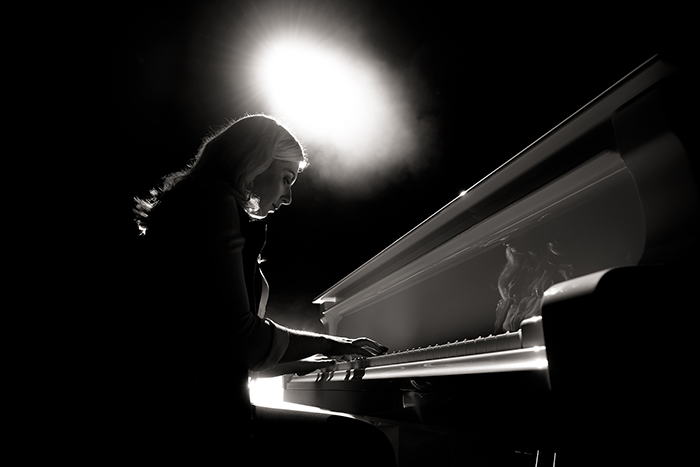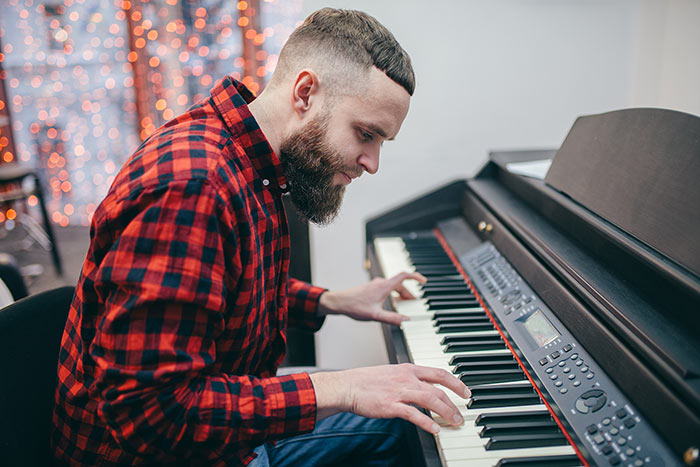Having to adapt to a different piano at each performance can sometimes be quite a tricky exercise. There are basically two standard acoustic pianos, namely the upright piano and the grand piano.
There is quite a significant difference between them, let alone having to play on any given piano except for the one you are used to playing on.
The upright piano has vertical strings and is more seen as the ‘household’ piano used for training children or plainly for a practice instrument. The action is that of hammers hitting against the vertically strung strings within an upright wooden body.
The grand piano is strung horizontally and the hammer action hitting from the bottom upwards. The sound of the concert grand is much richer and more beautiful than a small ‘baby grand’ which are overstrung. When one has to perform on an instrument, it’s vital to have a practice performance, so as to ‘feel’ the instrument as in feeling the resistance of the notes or keys when pressed down, as well as to hear the sound and test the position of the pedals and chair.
Take your time to feel and hear and test the instrument, so that you will feel comfortable with performance.
When you do find a situation where you are asked to perform and the piano is a challenge concerning maybe sound or tuning or notes not working properly, it can be quite alarming and nerve-wracking!
Best is to just decide to make the best of it, join the group and have fun as far as possible.
At least it will be like playing an old blues piano – like a honky-tonk piano in a bar!
Time to adjust and in your mind become Monk playing his jazz piano pieces with great success and many today would give a lot just to be able to play even close to what he did!
As mentioned, do give attention to the stool or chair that is offered that it can be adjustable or bring your own with the correct height that works for you. Sitting too high or too low can really affect your concentration and technique during a performance.
Also, make sure that the pedal is working well and make sure you do not have to wear special shoes to reach it properly. Some pedals can be very ‘high’ – so do test it.
It is an absolute must to try out or do a short rehearsal on the piano that you will be performing on. If not, it can be quite disturbing when one realises that the keys are either very hard or very loose. You might even find some are out of tune.
So it’s always wise to try out the instrument one will perform on so that you will be prepared and peaceful and able to give your best without having to think of notes, or chairs, or clothes etc. To give an example from my own life which was not at all funny at that time, but thinking of it now, it’s quite hilarious!
Aways dress that you feel comfortable and especially with regards to your shoes! Never use new shoes as it will affect you when walking and especially when having to pedal unless they have been walked in’ and comfortable. The heels need to be the height you are used to.
I had a very nasty experience performing at the ‘Musaion’ concert hall at The University of Pretoria in South Africa. We were a group performing various pieces and I was playing the Ab Major Ballade of Chopin. Not an easy piece at all.
In preparing for this event, I found a new pair of beautiful shoes with lovely heels – the newest look and all seemed good.
They fitted beautifully.
Well at the end as I went up the stage, I realized that these shoes were a bit floppy and high and when I came to the lovely concert grand, these shoes did not work with those pedals at all.
Well, needless to say, I had no other option but to try to ignore it and play, trying my utmost best to control the sustaining pedal with these horrific shoes!
The problem was that it threw off balance and all my concentration was on the pedal!
I got through the piece of music – but could not enjoy it nor pass on the emotions that I would have loved to convey to the audience.
The new-look was not worth it.
After that, I decided never again to give so much attention to the outside look as to the music that I wanted to convey.
Who really cares about our looks?
If the music is higher than our looks or ourselves – people can really enjoy and be taken into another world of great enjoyment!
Playing on digital pianos, keyboards or stage pianos
Artists are often these days asked to come to perform at an event where a digital piano is provided to perform on.
Therefore one needs to be able to adjust to these easily.
Digital portable pianos are very convenient for the travelling artist. That means you can take your own good stage piano or keyboard with to perform on. In that way, the artist has full control over the instrument. But should you not have this privilege and have to use a piano provided at your performance venue, it’s very important to test the piano or keyboard before a performance. On the digital piano, notes are in tune and at least there will be no false notes (not as in the possibility of an acoustic piano that can be tuned a bit “off” of the A144 hertz mark).
There are however other criteria that are important.
When testing the feel of a digital instrument, once again, feel the keys and make sure it will work for the music you are playing.
It is really difficult to play a fast Bach prelude on a lower-end keyboard or digital piano that does not have graded hammer action or weighted keys. There has to be enough resistance for your fingers as if you are used to an acoustic piano. Your fingers will be used to the resistance of having to push down a key fixed to a hammer on the inside of the piano. Some keyboards or even cheaper digital pianos are too ‘loose’ for a classical piano player and it becomes very difficult to control your technique and play evenly. This problem is absent on the higher-end digital pianos – rather called Stage pianos or performance pianos.
These are the best to play on and a real pleasure. The price is however not cheap, but worth it. Examples are like the Roland RD 800 or the Yamaha CP 300 just to give two examples. These performance digital pianos will either have a graded hammer action with a piano feel or have weighted keys.
The weighted keys action I personally enjoy more as it more resembles the acoustic piano.
These portable pianos are of course heavier than the cheaper graded hammer action pianos which are more digital and having less hardware.
Adjustment to your portable piano:
If you are playing a piece of music with deep bass notes one will need a good stage piano to be able to create the atmosphere you want. Some of the lower-end digital pianos can only sustain some notes and notes dies away soon after touch. Sustaining of sounds can be a problem. So do try out the keys you will be using to get the feel you need on the instrument and if you should adjust by peddling more or create more movement.
There is a very important element to take into account when performing on a digital piano or keyboard. Normally one talks of a keyboard or a workstation as of an instrument with many functions, used with many sounds for creating, sequencing or writing music and using orchestral sounds as well.
Most digital pianos or performance stage pianos only have a few settings for piano sounds like organ, vibraphone, guitar, and strings and a few others. It’s really important to play chords on the instrument and to hear or feel how many sounds the instrument can produce while putting your pedal down. It’s very frustrating when one wants to get a certain effect of continuing sound with a bass note that needs to be held with the pedal, just to find that it vanishes away! The reason is that the piano does not have enough ‘polyphony’ available (that is the number of notes that can be played together before the sounds start to cut out or fade.), so make sure that it can work for you – or you will have to repeat the bass note more often.
Before your performance, make sure the pedal is working properly and adjusted for sustaining for that specific model. If you find that it is not sustaining, you will have to change the polarity on the pedal or on the system.
Another element to take into account on your digital keys is when you want to change from one sound to another within your piece of music, one has to make sure that the piano allows for that and that it will be executed without a split second of a break.
On most of the stage pianos, this problem has been addressed but on the cheaper ones, there will be that split second of a delay or sound just disappearing and that is not OK at all during a performance.
So do test your performance instrument before performing that this will not affect you – then rather just stick to one sound.
Finally, the adjustment from one piano to another, or one digital piano to another can be a bit of an adjustment, but with a bit of testing and trying one can easily do the adjustment.
It’s important to test your instrument that you will perform on and then just to enjoy it!
Leave self-criticism or thinking about how others will esteem you, outside the door of the concert hall, as it will inhibit your playing.
Only be aware of the music.
Believe in your sound, give it and bless others with it!
Totally ignore all possibility of ‘mistakes’ or mishaps – just play and enjoy and you will do well!
I would also recommend reading my article on the art of performing the piano in public for more tips on improving your live piano performances!







